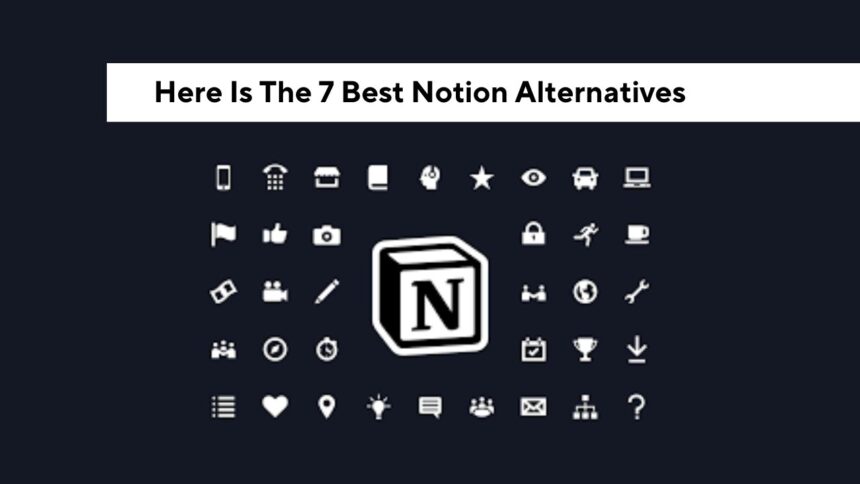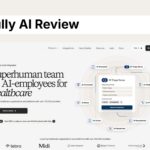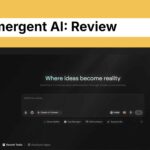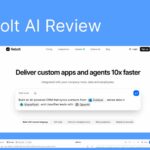I’ve just completed a major project, which involved several hours trying out AI-powered productivity applications and I can assure you that Notion is an absolute game changer.
But what happens if you reach your limits? Perhaps the sheer volume of data can be overwhelming for the team or you require a stronger database than Notion could provide.
I’m here to inform you that the perfect work space is right there!
I’ve personally put top competitors to test. I’m not only reading feature lists, I’m creating Wikis, managing the most complex projects, and directing my own second brain using these tools.
After sorting through hundreds of options of options, I’ve narrowed it down to seven absolute top options that truly are up to the task in.
Let’s look at the platforms that could transform your workflow!
1. Coda: The Nearest Competitor that has Killer Database Power
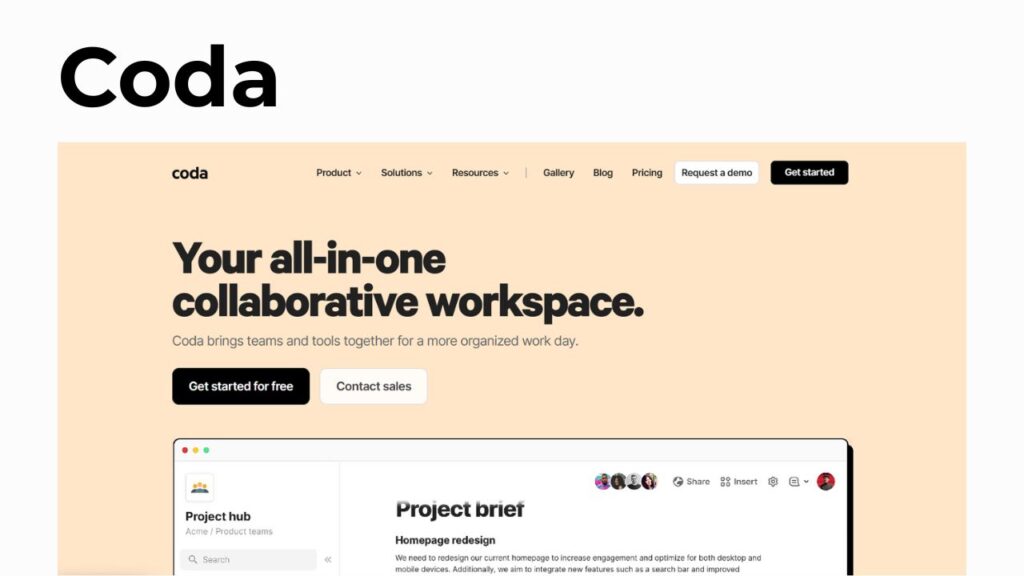
If you are a fan of notion’s “document-as-an-app” philosophy of Notion but require much more power underneath the top of the line, Coda is your next destination.
I was really impressed by the advanced features for managing projects and database functions. It was similar to Notion’s more sophisticated, business-savvy brother.
Coda’s Key Advantages:
- Docs that Communicate: Coda calls its documents “Packs,” which are integrations that allow your document to connect to and interact with other applications like Slack, Google Calendar, and Spotify more in depth than Notion’s embedded docs.
- Formula Powerhouse: Cuda’s formulas and functions are more powerful than Notion’s. If you’re creating internal applications that require complicated computations, conditionsal logic or heavy manipulation of data, Coda crushes it.
- User-Friendly Interface While Coda does have a learning curve because of its capabilities, I found the initial process of onboarding easier than Notion’s frequently blank-page apathy. It is actually a much simpler application to navigate once you start.
- Ideal for: Individuals and teams of small to medium size who appreciate Notion’s flexibility, but need formulas that are professional grade for automation, data visualization.
2. ClickUp: The Feature King for Project Management Teams
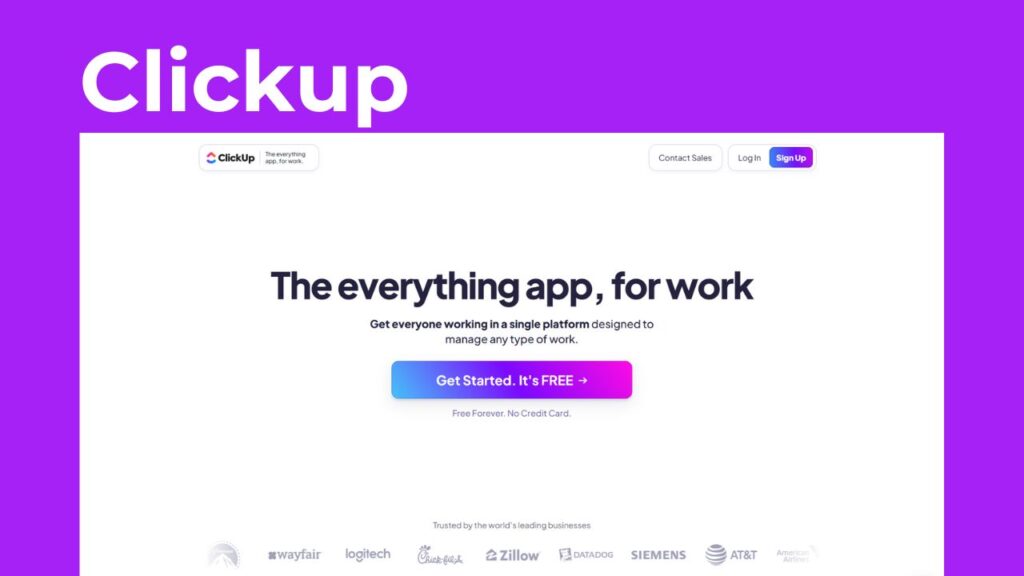
It excels at a lot of things, however the concept of dedicated management for projects is usually the last thing on the list. ClickUp transforms the script.
ClickUp is an all-in-one tool designed to facilitate the tracking of tasks and projects first, but with extensive document-related capabilities added over the top.
ClickUp’s Key Advantages:
- Command of Tasks ClickUp gives you an unbeatable level of power of control of tasks including customized statuses, targets, time-tracking and a wide array of perspectives (Gantt charts whiteboards, mind maps and more.) that Notion simply cannot compete with.
- The “One tool to Rule Them All’ The sound: It genuinely attempts to substitute all things. My favorite feature? Its chat tool that is specifically designed for it that makes it easier for teams to collaboration and omits that “comment-on-a-page” dance.
- Free and generous: The free-for-ever plan is awe-inspiring and sturdy enough for small groups to begin with however its complexity could be intimidating for an individual user.
- Ideal for: Project management teams companies, agencies, and other organizations who require a highly organized, flexible system to manage complicated tasks and multiple projects.
3. Obsidian: The Privacy-Focused Knowledge Manager

For the power user who is an individual or researcher who is interested to learn more about Personal Knowledge Management (PKM), Obsidian is an absolute game changer.
What’s the key difference? It’s offline first. Your files are simply Markdown files on the local disk drive providing you the highest level of security and control.
Obsidian’s Key Advantages:
- Linking Thinking (Graph View): This is the area where Obsidian excels. It employs bi-directional linking to show the connections to your notebooks in stunning graph view. This allows you to connect different ideas and develop an “second brain.”
- Performance and security It’s lightning fast because it’s a locally-based app. No loading time and immediate access. Furthermore, the fact that you can store your data locally means that you don’t need to be worried about security breaches on cloud servers.
- The Massive Plugin Ecosystem Obsidian is home to a vibrant community of developers who create hundreds of high-quality, free plugins that allow you to customize your workflow beyond Notion’s default options.
- is ideal for Individual students, writers, researchers and other privacy-conscious users who require an online, extremely personalized and connected knowledge base.
4. AppFlowy

AppFlowy is a cutting-edge open-source project management, as well as note-taking tool that is frequently marketed as a privacy-focused alternative proprietary software such as Notion.
It’s designed to be an AI collaborative workspace where people as well as teams manage projects, create wikis, and produce beautiful and organized documents while maintaining control over their information.
Key Features and Highlights:
- open-source and data ownership This is the AppFlowy’s biggest selling feature. Being open-source permits the community to contribute and inspect the code. Importantly, it offers alternatives for hosting your own server and 24/7 offline support giving users total control and responsibility over their personal data, and guaranteeing maximum security.
- Native Apps for Cross-Platforms: AppFlowy is built using Flutter and Rust that lets you enjoy rapid, native performance on every major platform which include Windows, macOS, Linux, iOS, and Android.
- Notion-Like Interface: User experience like Notion This helps to make those who are used to block-based editors. It is compatible with:
- Rich Content Types There are more than twenty types of block content, which include images, to-dos block code, math equations.
- Databases Views that can be customized for managing data, like Grid (Table) Kanban Boards, as well as calendar views.
- AI Integration The program includes AI features (often using models such as GPT-4 and Claude) to assist with tasks like creating drafts or improving writing, examining grammar, and extracting information from text. It also allows you to execute the local models of AI on your computer to ensure complete security.
- Collaboration The platform allows inviting team members to join a workspace, real-time collaborative via pages, as well as the creation of an online knowledge base.
5. Microsoft Loop: The Ecosystem Integrator

If you have a team that runs using Microsoft 365 (Teams, Outlook, Word), Microsoft Loop is the most transparent alternative.
It’s based on the concept of “Loop Components”–small embedded pieces of collaborative content (like an agenda or tables) that are visible on the page, but are able to be copied or pasted in order to remain at a constant state across the various Microsoft applications.
Microsoft Loop’s Key Advantages:
- Seamless Integration The HTML0 Seamless Integration is built to seamlessly integrate into Microsoft’s Microsoft ecosystem. Editing documents in co-editing and embedding it into an Outlook email, Teams chat, or Outlook email is amazing.
- Real-Time Collaboration The real-time collaboration offered by Loop is extremely smooth, comparing to the functionality of Google Doc but with the structure of the Notion page.
- Familiar Interface People who are already familiar using Microsoft products will be able to make the design and feel immediately familiar, dramatically reducing their learning curve.
- is ideal for Teams, particularly large corporations, that have adopted Microsoft 365. Microsoft 365 suite and need an efficient collaborative workspace to go with the existing tools.
6. Miro

Miro is a well-known collaborative platform for visuals which acts as an infinite whiteboard online that allows teams collaborate whether in the same space or remote, or hybrid.
It is designed to assist in visualizing ideas, concepts as well as planning and design within a adaptable and collaborative digital environment.
Here’s a brief overview of the functions Miro is and the key features it has:
Core Purpose
Miro acts as an visual workspace to foster the development of ideas. Its principal strength lies in the ability to facilitate real-time and synchronous collaboration. an expansive expanse of flexible canvas that teams can:
- Brainstorm to sketch out ideas.
- Plan plans, roadmaps and agile workflows.
- Designs customer routes, user flows and wireframes.
- Use interactive workshops and meetings (e.g. retrospectives or Design sprints).
Key Features of Miro
- Unlimited Canvas: Provides a unlimited virtual space that is able to adapt to the needs of any group by letting you expand and contract, and create complicated projects.
- Rich Library of Tools:
- digital Sticky Notes and text.
- Diagramming tools for mind maps, flowcharts concepts maps, and flowcharts.
- Drawing tools, such as the Pen tool that converts drawings into shapes.
- Support for embedding a variety of types of files (images PDFs documents, spreadsheets, images).
- Templates: A vast collection of pre-made customized templates that can be adapted to specific scenarios such as:
- Mind Maps
- Kanban Boards
- User Story Maps
- Business Model Canvas
- Agile events (like Retrospectives and PI planning)
- Real-Time Collaboration Tools: Features that help make hybrid and remote work seem natural and enjoyable:
- Live Cursors to find out where other are working.
- Comments and Tags to facilitate asynchronous discussions.
- Voting tool for group decision-making.
- Timers tool to help keep workshops on the right track.
- Present Mode for guiding the participants around the board.
- Integrations Miro integrates numerous popular tools for work to simplify workflows, such as Slack, Jira, Trello, Zoom, and Microsoft Teams.
In the simplest sense, Miro is a tool for teams who require an open, collaborative and highly visible space to think and plan and bridges that gap in between whiteboard that is physically present as well as digital management of projects.
7. Evernote: The Clip-and-Save Classic, Reborn
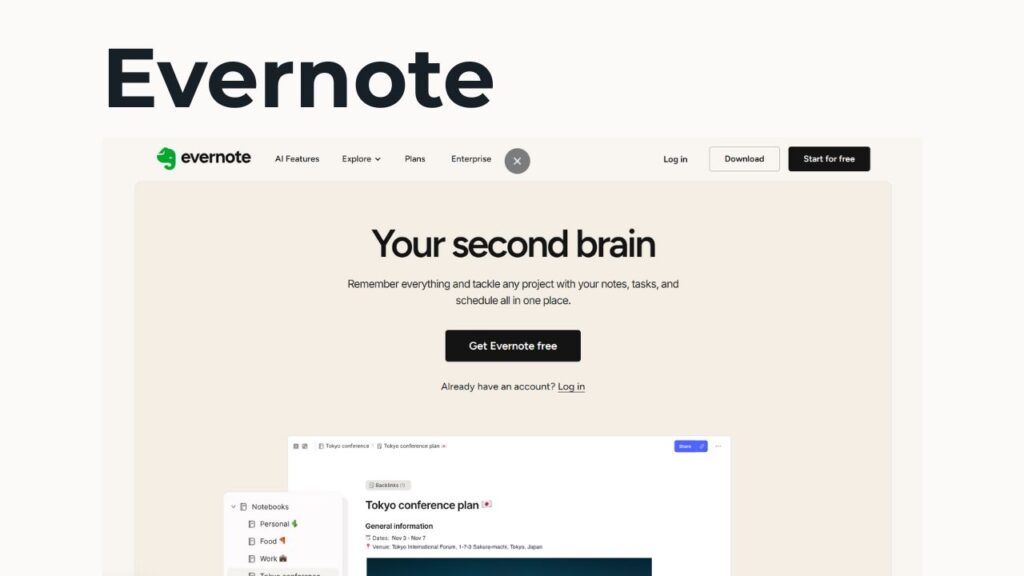
I am aware that Evernote may be an old brand however, it has experienced an major rebirth. If your primary goal for Notion is recording and retrieving information such as web images, clippings, scans of documents, or quick thoughts Evernote remains still one of the top on the market.
Evernote’s Key Advantages:
- Best-in-Class Capture The Web Clipper as well as mobile scanners are unmatched. There is no other tool that allows you to store an item, create an image to a PDF, or even scan a whiteboard to let it be searchable instantly.
- Strong Search The search capabilities of Evernote are famous. It can locate text in scans of PDFs, images and even notes written by hand with incredible precision and makes it the most reliable source for searching for details.
- The focus is on notes: The focus is on one task flawlessly it is a strong and organized online filing cabinet. There’s no project management clutter and just simple, reliable note-taking.
- Ideal for: Journalists, students professionals, and anyone who are looking for an effective solid “digital brain” for capturing and immediately retrieving any form in unstructured information.
Why You Should Trust My Review
I don’t write reviews to create content I create them from actual experiences.
The tools I analyze are the same tools that I and my team employ in our work.
Before I endorse anything I test it personally in various tasks such as marketing, content creation video production and so on.
I am constantly exploring every feature, looking for what works and what isn’t.
If a tool is truly helping us save time, increase quality, or yield greater results, only then should I recommend it to others.
My objective is to help people just like you make better decisions, without spending money or time.
I understand how difficult it can be to pick the most appropriate tool, which is why I only speak about what I have used and trust myself.
Conclusion
The main point is that Notion is an extremely customizable blank canvas, however its limitations and complexity in particular areas make room for the best rivals in the market to stand out.
| If you are looking for a primary need… | My top recommendation would be… | The reason it is so successful… |
| Advanced formulas and complicated data applications | Coda | The more powerful databases are complemented by the richer “Packs” functionality. |
| Feature-rich project/task management | ClickUp | Unbeatable in tasks hierarchy Custom statuses, task hierarchy, and view of projects. |
| Privacy PKM, HTML0 and connected thinking | Obsidian | Offline-first, bi-directional linking and a superior Graph View. |
| Ownership of data and the open source control | AppFlowy | Native performance and completely offline mode and the ability to host your own server and manage your data. |
| Non-frictionless MS 365 integration | Microsoft Loop | Instant real-time collaboration in Outlook Teams and Teams. |
| Visual design and planning | Miro | It is designed to help with visualization of ideas, concepts as well as planning and design |
| The capture, scan and a powerful search | Evernote | Unbeatable Web Clipper and the ability to search for text in any type of file. |
Don’t be reluctant to try some! After all my testing, I’m confident that the right tool will help you save hundreds of hours – and this, dear reader is an unimaginable benefit.


